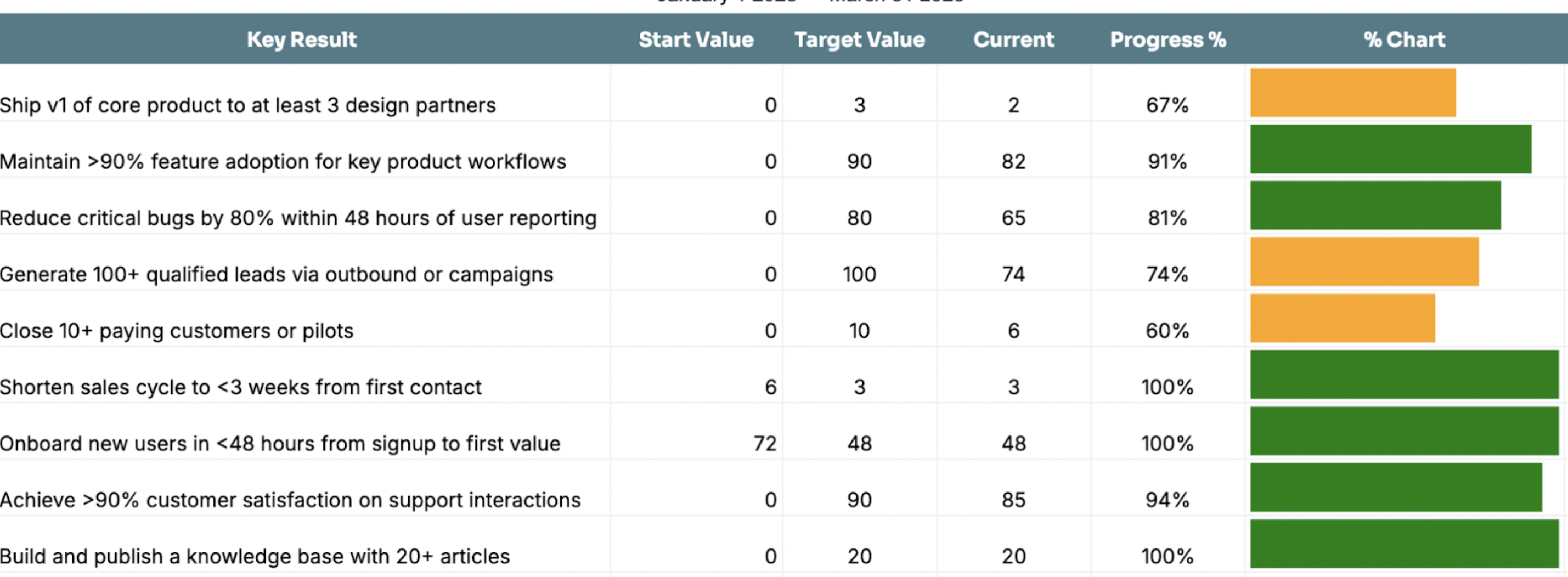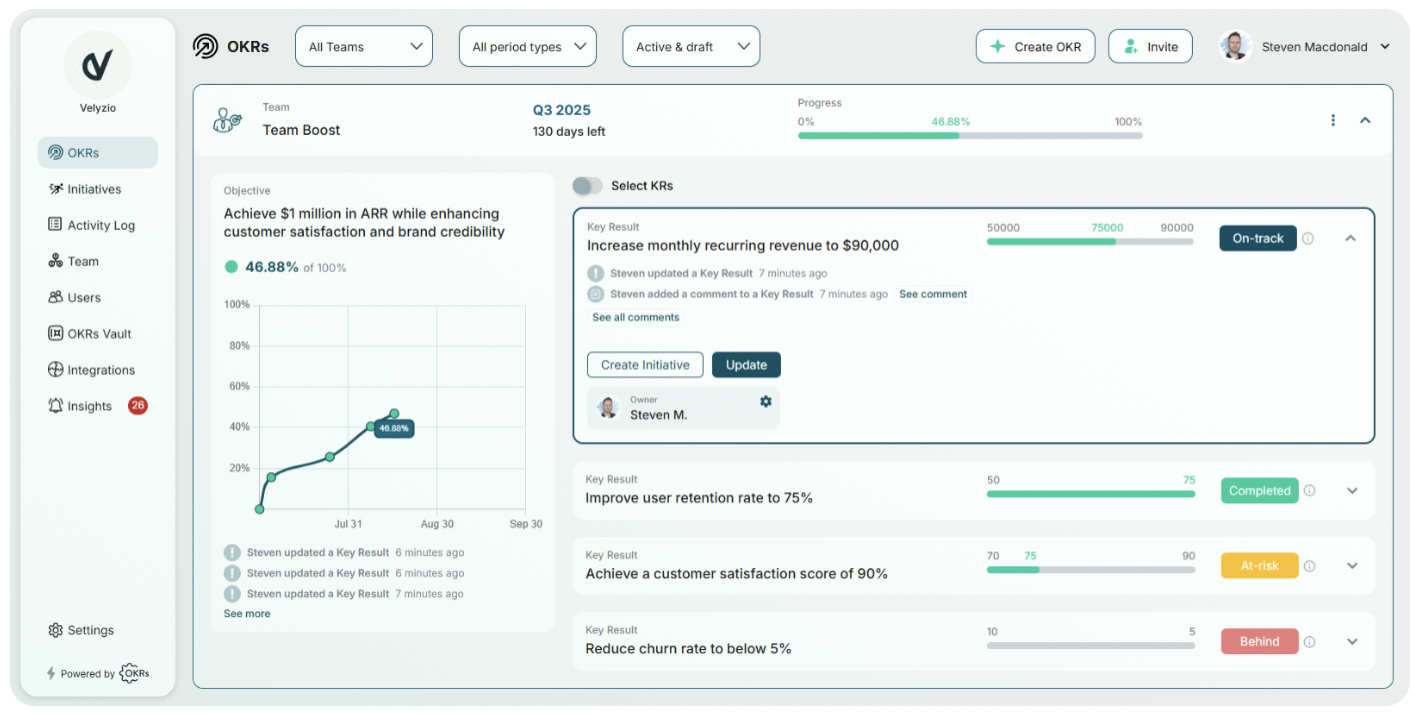At some stage, every startup hears about OKRs.
Popularized by Google and adopted by thousands of high-growth teams, OKRs (Objectives and Key Results) promise a simple way to align focus, track progress, and scale execution without chaos.
Sooner or later, every founder asks the same question:
Do we really need OKRs?
Some teams jump in too early and drown in the process. Others wait too long and lose alignment. The truth is, whether OKRs help or hurt depends entirely on when - and how - you start.
At five people, goals live in conversation. At fifteen, you start missing details. By thirty, priorities split across functions, and suddenly no one’s sure what “done” really means. That’s usually when OKRs enter the chat.
But here’s the challenge: there’s no single right way to roll them out.
Some teams build spreadsheets. Others buy enterprise tools or hire consultants.
Many just do nothing and hope alignment holds.
This workbook helps you cut through the noise.
It breaks down the six most common paths startups take when considering OKRs - each with its pros, cons, and what it reveals about your team’s readiness.
By the end, you’ll know exactly where your company stands - and whether now’s the moment to introduce OKRs (or to wait a little longer).
Before You Pick a Method, Pick a Mindset
OKRs aren’t a box-ticking exercise. They’re a system for focus and alignment - but only if your team’s ready to commit.
If you go too light (like a spreadsheet), you’ll never build habits.
If you go too heavy (like enterprise software), you’ll add process faster than progress.
The goal isn’t to copy Google’s OKR system - it’s to create a rhythm your team will actually stick to.
💡 Think of this article as your field guide. By the end, you’ll know whether you’re ready for OKRs - and if so, what type of system fits your team best.
The 5 Paths Startups Take (and What They Reveal)
Every company reaches a point where goals start slipping through the cracks. Some teams rush to fix it with tools or frameworks. Others hold off and hope communication alone will hold alignment together.
Each of the following paths represents a real decision startups face when they first consider OKRs - from doing nothing to rolling out full platforms. Understanding where you are on this spectrum is the first step to knowing what your next move should be.
1. Do Nothing
For many startups, “no OKRs” feels natural at the beginning. With a handful of people, alignment happens organically. You don’t need dashboards - you just talk.
But as the team grows, that breaks. You start hearing “I didn’t know we were doing that,” or “Wait, is that still a priority?” The clarity that once came for free now costs energy to maintain.
Pros: Zero setup, full flexibility.
Cons: Goals drift, accountability fades, and visibility disappears.
Doing nothing works when everyone’s in the same room. The moment you add new hires, time zones, or multiple priorities - it stops scaling.
Verdict: Fine for teams under 10. Beyond that, chaos creeps in.
2. Use Spreadsheets
The humble spreadsheet is the most common entry point into OKRs - and often the most short-lived. It’s fast, free, and familiar. You can list objectives, assign owners, and even color-code progress.

But spreadsheets don’t send reminders, track updates, or encourage reflection. They rely on perfect discipline - something startups rarely have time for.
Pros: Easy setup, fully customizable, no cost.
Cons: Becomes messy fast. No ownership trail. Hard to maintain consistency.
Most teams outgrow their OKR spreadsheet by the second cycle. What starts as a clever hack becomes a cluttered archive of half-updated goals.
Verdict: Great sandbox for learning the OKR framework. Poor system for sustaining it.
3. Run OKRs in Docs or Slides
Docs and slides feel like an upgrade. They’re great for adding context - the why behind each goal - and simple enough that anyone can read or edit them.
But they share the same fatal flaw as spreadsheets: no feedback loop. There’s no trigger to check in, no view of progress, and no momentum.
Pros: Simple, visual, and accessible to all.
Cons: Static, manual, and easy to forget.
Teams often confuse documentation with alignment. A well-written OKR doc doesn’t keep your team accountable - action does.
Verdict: A good communication tool. Not a management system.
4. Buy Enterprise OKR Software
This is the overcorrection stage. Founders see their teams struggling and assume the fix is “professional” software. So they sign up for an OKR platform with dashboards, HR tie-ins, and strategy maps designed for enterprises with hundreds of employees.
The result? Instant feature fatigue.
Pros: Deep integrations, analytics, and hierarchy mapping.
Cons: Overkill for small teams; complex setup and per-user costs.
For a 25-person startup, enterprise OKR software often adds more friction than focus. You’ll spend weeks setting it up before you set your first meaningful goal.
Verdict: Built for scale - but not for speed.
5. Hire OKR Consultants or Coaches
Hiring an OKR coach is like paying for acceleration. They’ll help you craft your first OKRs, run workshops, and guide accountability.
It’s incredibly helpful - until they leave.
Without an internal system to maintain the rhythm, most teams revert to old habits within a quarter. The consultant creates clarity, but not ownership.
Pros: Expert guidance and quick implementation.
Cons: Expensive and unsustainable long term.
Think of a coach as scaffolding. They help you build faster - but you still need a foundation underneath.
Verdict: Smart for your first OKR cycle. Risky if you rely on it too long.
The Best Solution? Use OKRs Tool
This is where structured simplicity wins.
OKRs Tool is built for startups that want clarity without complexity - a system that scales with the team, not against it.

It takes minutes to set up, encourages weekly async check-ins, and makes ownership visible by design. With flat pricing and AI-assisted OKR writing, it’s light enough for founders to adopt fast - and structured enough to keep teams accountable quarter after quarter.
Pros: Fast onboarding, affordable, async-friendly, with insights built in.
Cons: Like any new habit, it takes a few weeks to stick.
And it’s working - teams everywhere are proving that structure and speed can actually go hand in hand.
Verdict: Ideal for startups ready to graduate from spreadsheets to OKR software and make OKRs a team habit.
Comparison: How Startups Approach OKRs
Every team starts somewhere. Here’s how these six common approaches stack up - and what they reveal about your readiness for OKRs.
Most startups land somewhere in the middle - experimenting with structure while trying to avoid the overhead of heavy systems.
What the Self-Assessment Tells You
If you’re still in the “Do nothing” or “Spreadsheet” zone, you don’t need a full-blown OKR rollout yet. You need alignment habits - weekly check-ins, shared priorities, visible progress. Once those are consistent, OKRs will feel natural.
If you’re already tracking goals but losing visibility or consistency, you’re ready for structure. A lightweight system like OKRs Tool builds accountability without bogging you down in process.
And if you’re tempted by big-ticket OKR software or consultants? Start smaller. You’ll learn faster and spend less.
Start Small, But Start Now
The question isn’t whether you need OKRs - it’s whether you’re ready to use them well.
OKRs don’t fix chaos by themselves. They amplify whatever rhythm your team already has. If your culture values focus, clarity, and ownership, OKRs will multiply that. If it doesn’t, they’ll only expose the cracks.
So before you sign up for a platform or workshop, take a step back:
- Is your team aligned on priorities?
- Do you review progress weekly?
- Does every major goal have a clear owner?
If not, start there. Then layer OKRs on top when you’re ready.
And when that moment comes - when you’re ready for structure without bloat - OKRs Tool is built for exactly that stage: small, growing teams who want clarity that scales.






